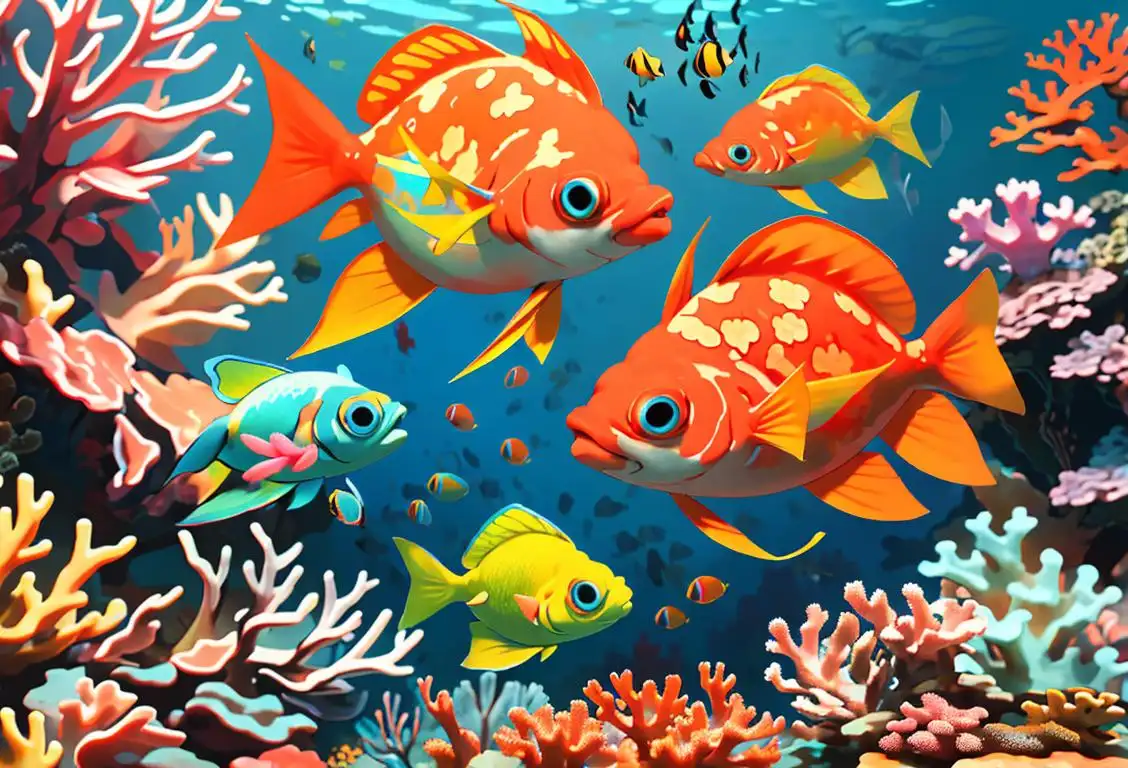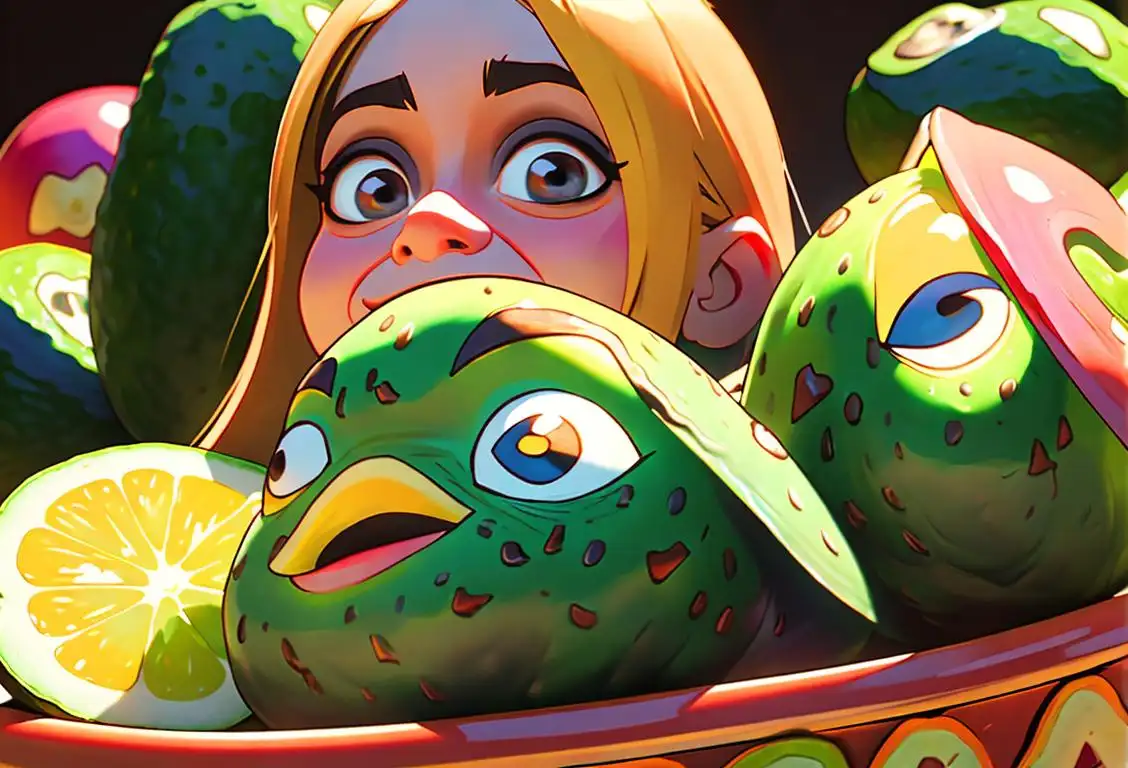National Salmon Day

Welcome to the wonderful world of National Salmon Day! Get ready to dive into the depths of this aquatic celebration and reel in some fascinating facts. Whether you're a lover of seafood or just a fan of puns, this national day is sure to make a splash!
When is Salmon Day?
It's national salmon day on the 27th September.
The Origins of National Salmon Day
Every year on September 27th, people across the internet celebrate National Salmon Day. But how did this fin-tastic holiday come to be? Well, the history of National Salmon Day can be traced back to the depths of the internet, where a group of seafood enthusiasts decided it was time to give these fishy creatures the recognition they deserve.
A Fin-fluential Fish
Salmon, with their distinctive pinkish-orange flesh, are not only a delicious and nutritious food source but also an iconic symbol of the great outdoors. These remarkable fish swim against the current, leaping up waterfalls to reach their spawning grounds. Their extraordinary journey has captured the hearts of many and inspired a day dedicated to honoring their strength and perseverance.
Salmon in the Digital Age
With the rise of social media and the internet's insatiable appetite for quirky holidays, National Salmon Day quickly gained popularity. Online communities banded together to share salmon-related memes, recipes, and even participate in salmon-themed challenges. People began hosting salmon dinners, salmon fishing tournaments, and some even dressed up as salmon for costume parties. It's safe to say that the internet went completely off the scales in celebrating these magnificent fish!
Celebrating National Salmon Day Today
As National Salmon Day continues to make waves around the world wide web, people find creative ways to join in the festivities. Some opt to whip up mouthwatering salmon dishes in the kitchen, experimenting with different seasonings and flavors. Others take to the outdoors, heading to rivers and streams, hoping to catch a glimpse of these incredible creatures in their natural habitat.
Let's not forget about our friends in the online gaming community! Many video games feature salmon as a valuable resource or a formidable opponent, giving players a chance to immerse themselves in an underwater adventure.
Whether you're a salmon aficionado, an internet enthusiast, or simply someone looking for a reason to celebrate, National Salmon Day is the perfect opportunity to swim against the current and join in the fun!
History behind the term 'Salmon'
800 AD
The Founding of the Word
The term 'salmon' originates from the Old French word 'saumon,' which was derived from the Latin word 'salmo.' 'Salmo' originally referred to a leaping fish and was used to describe the fish we now know as salmon. The Latin word itself may have roots in the Etruscan language, an ancient language spoken in Italy.
4000 BCE
Ancient Beginnings
Salmon have been an integral part of human history for millennia. Archaeological evidence suggests that salmon were caught and consumed by humans as early as 4000 BCE. Native American tribes along the Pacific Northwest, particularly the Chinook, Salish, and Haida, relied heavily on salmon for sustenance.
3000 BCE
Early records of salmon consumption
In 3000 BCE, early records show that salmon was being consumed by ancient civilizations. The Mesopotamians, Egyptians, and Phoenicians were some of the first civilizations to appreciate the delicious taste of salmon. Their culinary skills extended to marinating, grilling, and smoking the fish, resulting in unique flavors and preservation techniques that are still used today.
Ancient times
The salmon's ancestry
Salmon, a term derived from Latin 'salmo', traces its ancestry back to ancient times. The Atlantic salmon, a species of salmon found in the northern Atlantic Ocean, belongs to the family Salmonidae. This family also includes other well-known fish like trout and grayling. These fish have been highly regarded throughout history for their taste and nutritional value.
5000 BC
The Rise of Salmon
Salmon has a long and storied history that dates back to around 5000 BC. Native people in North America, as well as indigenous communities around the world, have relied on salmon as a crucial food source for thousands of years. The abundance of salmon in rivers and streams made it a valuable resource for sustenance and trade.
34,000 BCE
Early Evidence of Salmon Consumption
Archaeological evidence suggests that humans have been consuming salmon for over 34,000 years. In caves near the White Sea in Russia, preserved salmon bones and scales have been found, indicating that early humans relied on salmon as a source of food and sustenance.
Year 1523
Introduction to 'salmon'
The term 'salmon' was first introduced in the English language in the year 1523. It originated from the Middle English word 'samoun' which was derived from the Old French word 'saumon'. The Old French term 'saumon' can be traced back to the Latin word 'salmo', which refers to the fish species known as salmon.
1000 AD
Symbol of Transformation
Salmon has been culturally significant in various regions. In Norse mythology, the salmon played a prominent role. It was believed that the knowledge of the world resided within the salmon, and anyone who consumed its flesh would gain great wisdom. This symbolism highlights the spiritual and transformative nature associated with the fish.
500 AD
Salmon in European Cuisine
Salmon began appearing in European cuisine around the 5th century AD. The Romans were particularly fond of this fish and cultivated salmon as a luxury food. The term 'salmon' itself is derived from the Latin word 'salmo,' which means 'leaper' or 'the one who leaps,' referencing the fish's ability to jump up waterfalls to spawn.
Native American cultures (thousands of years ago)
Salmon in Native American culture
For thousands of years, Native American tribes in North America have relied on the salmon for sustenance and cultural significance. Salmon served as a vital food source, with some tribes even organizing annual salmon runs. They developed effective fishing techniques and built complex systems of weirs and traps to catch salmon during spawning runs. These practices showcased the deep connection between Native American cultures and the salmon.
2000 BCE
Salmon in Ancient Cultures
Salmon played a significant role in the cultures of the ancient Greeks and Romans. In Greek mythology, salmon were believed to be sacred and associated with the gods. The Romans considered salmon a luxury food and even developed special tools, such as silver scales, to assist in eating this prized fish.
684 BCE
Salmon in Greek mythology
Greek mythology has also played a significant role in the salmon's cultural significance. In 684 BCE, the Greek poet Hesiod mentioned salmon in his epic poem 'Works and Days.' According to the myth, the Greek god Zeus transformed the Aloadae twins into salmon to escape their wrath. This connection established salmon as a symbol of transformation and resilience in ancient Greek culture.
Year 1612
Cultural significance of salmon
The term 'salmon' gained cultural significance due to the popularity of this fish as a food source and its representation in various cultures. In many ancient civilizations, such as the Norse, Celtic, and Native American cultures, salmon held a special place in their traditions and mythology. It was often associated with strength, wisdom, and spirituality.
1739
Scientific Classification
In 1739, Carl Linnaeus, a Swedish botanist and physician, formally classified salmon under the scientific name Salmo salar. Linnaeus' work in taxonomy helped establish a standardized naming system for plants and animals, bringing order to the study of species. The Latin name Salmo salar is still widely used today to refer to Atlantic salmon.
16th Century
The Term 'Salmon' Emerges
The word 'salmon' originates from the Latin word 'salmo,' which was derived from the earlier Latin term 'salire,' meaning 'to leap.' This name was likely inspired by the salmon's ability to leap up rivers and waterfalls during their migratory journeys.
14th Century
The Rise of Aquaculture
Aquaculture, or fish farming, began gaining popularity in Europe during the 14th century. Salmon was one of the fish species that was actively cultivated due to its nutritious value and delicious taste. This marked a significant step in the history of cultivating and domesticating salmon for human consumption.
1864
Commercial Salmon Fisheries
The development of commercial salmon fisheries began in the late 19th century, particularly in North America. Companies started to establish canneries along rivers and coasts, allowing for the mass production and export of canned salmon. This marked a shift in the way salmon was harvested, as it moved beyond a subsistence food source to become an industry.
Year 1784
Scientific classification
In 1784, the Swedish scientist Carl Linnaeus, known as the 'Father of Taxonomy', formally classified the salmon species under the scientific name 'Salmo salar' within the family Salmonidae. This classification system helped establish a standard name for the species across different languages and regions.
19th Century
Salmon Fishing Industry
During the 19th century, the salmon fishing industry boomed in both Europe and North America. Advances in technology, such as the invention of canning and refrigeration, allowed salmon to be preserved and transported over long distances. This led to increased commercialization of salmon as a sought-after food item.
11th century
Salmon fishing laws in Scotland
During the 11th century, specific laws were enacted in Scotland to protect salmon fishing grounds. These laws were a testament to the economic and cultural importance of salmon during that time. The salmon was highly valued as a food source and a lucrative trade commodity, demonstrating its impact on the local Scottish culture and economy.
Medieval Europe (5th - 15th century)
Introduction of salmon as a delicacy
During the medieval period in Europe, salmon gained popularity as a luxurious food item among the nobility. It became synonymous with wealth and high social status. The salmon's flavorful flesh and rich taste led to its inclusion in the menus of lavish banquets hosted by royalty. The demand for fresh salmon grew, leading to the establishment of specialized fishmongers and the development of preservation techniques like smoking and salting.
19th Century
The Salmon Industry
The 19th century saw the rise of the commercial salmon industry. Improved transportation systems, such as the railway networks, allowed for fresh salmon to be transported across long distances. This led to increased availability and popularity of salmon as a food source. It became a sought-after delicacy in many countries.
1968
Wild Salmon Conservation
Concerns about declining salmon populations led to the formation of organizations dedicated to salmon conservation. In 1968, the Wild Salmon Center was established in Portland, Oregon, with the mission of protecting and restoring wild salmon ecosystems. Efforts like this have been instrumental in raising awareness about the importance of preserving salmon habitats.
18th Century
Salmon Fishing Becomes Popular
In the 18th century, salmon fishing became a popular recreational activity in Europe. Wealthy individuals would travel to rivers and streams to enjoy the thrill of catching salmon. This increased the demand for salmon and led to the establishment of commercial fisheries.
18th and 19th centuries
Salmon as a commercial industry
In the 18th and 19th centuries, the commercial salmon fishing industry began to flourish. The discovery of abundant salmon populations in North America, particularly in the Pacific Northwest and Alaska, sparked a significant expansion in salmon canneries and fishing practices. Canned salmon became a staple food for settlers and played a pivotal role in feeding the growing population of the United States and Europe.
19th century
Salmon canning industry
The 19th century witnessed the rise of the salmon canning industry, which transformed the availability and consumption of salmon. In 1820, the first commercial salmon cannery was established in the United States, marking the beginning of an industry that would revolutionize the way salmon was preserved and distributed. Canned salmon became popular worldwide, allowing people to enjoy this delicacy beyond coastal regions.
1952
Salmon Farming
In 1952, Atlantic salmon were successfully farmed for the first time, revolutionizing the salmon industry. The practice of salmon farming, also known as aquaculture, involves raising salmon in controlled environments such as tanks, ponds, or sea cages. This method allows for increased production, consistent supply, and reduced pressure on wild salmon populations.
Year 1879
Commercial salmon fishing
The late 19th century witnessed the growth of commercial salmon fishing industries, particularly in North America, Europe, and Asia. This led to the increased use and recognition of the term 'salmon' in international trade and culinary contexts. The demand for salmon grew exponentially, and it became an important commodity.
20th Century
Conservation and Environmental Concerns
In the 20th century, conservation efforts and environmental concerns regarding salmon populations began to emerge. Overfishing, habitat destruction, and pollution threatened the survival of many salmon species. Governments and organizations started implementing measures to protect and preserve salmon populations, ensuring their continued existence for future generations.
1985
Salmon Conservation Efforts
As awareness grew about the decline of wild salmon populations due to overfishing, habitat degradation, and other factors, significant conservation efforts were made. Organizations like the Pacific Salmon Commission and various environmental groups worked to protect and restore salmon habitats, implement sustainable fishing practices, and support the recovery of wild salmon stocks.
Year 1980
Conservation efforts and salmon farming
In the 1980s, concerns over declining wild salmon populations led to increased focus on conservation efforts and the development of salmon farming techniques. Salmon farming, also known as aquaculture, aimed to provide a sustainable and controlled environment for salmon production. This introduced the concept of 'farmed salmon' to the public and expanded the usage of the term 'salmon' beyond wild-caught fish.
20th century
Conservation efforts and salmon protection
As the recognition of salmon as an important ecological, cultural, and economic resource grew, efforts were made to protect and conserve wild salmon populations. Various organizations and government bodies implemented measures such as fish hatcheries, fishery regulations, and habitat restoration projects to prevent the decline of salmon species. Today, salmon conservation continues to be a priority to preserve these remarkable fish for future generations.
20th century
Salmon conservation efforts
The 20th century brought significant attention to salmon conservation efforts. Due to overfishing and habitat destruction, salmon populations faced severe declines worldwide. Various organizations and governments implemented conservation measures to protect these iconic fish. These efforts led to the establishment of salmon breeding programs, habitat restoration projects, and fishing regulations to ensure the survival of salmon and preserve their cultural and ecological importance.
Present Day
Culinary Delicacy and Environmental Symbol
Salmon has become a popular culinary delicacy, enjoyed in various forms such as smoked, grilled, or poached. The fish's rich flavor and high nutritional value have contributed to its popularity. Furthermore, living in both saltwater and freshwater, salmon also serves as an environmental symbol, showcasing the delicate balance between human activities and the preservation of diverse ecosystems.
19th Century
Salmon Conservation Efforts
With the rise of industrialization and overfishing, salmon populations started declining in the 19th century. Concerned conservationists and scientists began advocating for the protection of salmon habitats and the regulation of fishing practices to preserve these magnificent fish for future generations.
20th Century
Salmon Farming and Aquaculture
In the 20th century, salmon farming and aquaculture gained prominence as a means to meet the growing demand for salmon. Techniques were developed to raise salmon in controlled environments, ensuring a more sustainable source of this popular fish. Salmon farming has since become a major industry worldwide.
Did you know?
Did you know that salmon are able to detect their home river's unique scent even after spending years in the open ocean? These incredible fish have an extraordinary sense of smell!Tagged
awareness food fun natureFirst identified
7th October 2015Most mentioned on
27th September 2016Total mentions
170Other days
Parks Are Free Day
Fish Day
Salmon Day
Public Lands Day
Pumpkin Day
Foundation Day
Bacon Day
Vodka Day
Cheese Pizza Day
Guac Day








